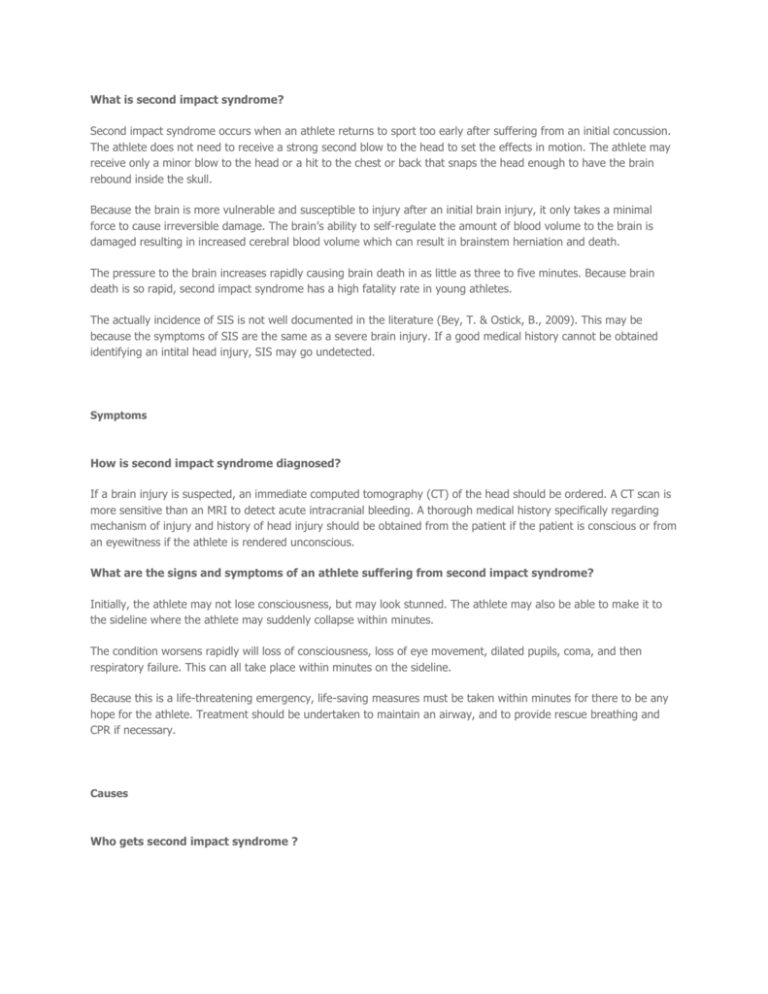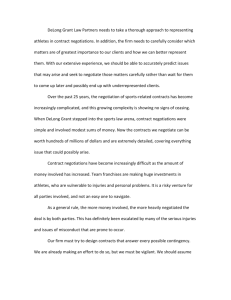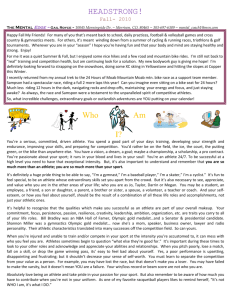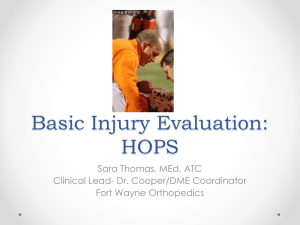What is Second Impact Syndrome?
advertisement

What is second impact syndrome? Second impact syndrome occurs when an athlete returns to sport too early after suffering from an initial concussion. The athlete does not need to receive a strong second blow to the head to set the effects in motion. The athlete may receive only a minor blow to the head or a hit to the chest or back that snaps the head enough to have the brain rebound inside the skull. Because the brain is more vulnerable and susceptible to injury after an initial brain injury, it only takes a minimal force to cause irreversible damage. The brain’s ability to self-regulate the amount of blood volume to the brain is damaged resulting in increased cerebral blood volume which can result in brainstem herniation and death. The pressure to the brain increases rapidly causing brain death in as little as three to five minutes. Because brain death is so rapid, second impact syndrome has a high fatality rate in young athletes. The actually incidence of SIS is not well documented in the literature (Bey, T. & Ostick, B., 2009). This may be because the symptoms of SIS are the same as a severe brain injury. If a good medical history cannot be obtained identifying an intital head injury, SIS may go undetected. Symptoms How is second impact syndrome diagnosed? If a brain injury is suspected, an immediate computed tomography (CT) of the head should be ordered. A CT scan is more sensitive than an MRI to detect acute intracranial bleeding. A thorough medical history specifically regarding mechanism of injury and history of head injury should be obtained from the patient if the patient is conscious or from an eyewitness if the athlete is rendered unconscious. What are the signs and symptoms of an athlete suffering from second impact syndrome? Initially, the athlete may not lose consciousness, but may look stunned. The athlete may also be able to make it to the sideline where the athlete may suddenly collapse within minutes. The condition worsens rapidly will loss of consciousness, loss of eye movement, dilated pupils, coma, and then respiratory failure. This can all take place within minutes on the sideline. Because this is a life-threatening emergency, life-saving measures must be taken within minutes for there to be any hope for the athlete. Treatment should be undertaken to maintain an airway, and to provide rescue breathing and CPR if necessary. Causes Who gets second impact syndrome ? Any athlete may be at risk for SIS if he/she returns to sports competition while still experiencing the symptoms from an initial injury. According to a study published in the Journal of Athletic Training (2007) and published on Neurotrauma Research Laboratory website, between 1.6 and 3.8 million sport-related concussions occur every year. The collegiate sports with a higher incidence of concussion include in descending order using injury rate per 1000 athletes exposed (IR/AE): • • • • • • • • • • • • Football (2.34) Men’s Ice Hockey (1.47) Women’s Soccer (1.42) Wrestling (1.27) Men’s Soccer (1.08) Women’s Lacrosse (0.70) Field Hockey (0.57) Women’s Basketball (0.50) Men’s Basketball (0.32) Softball (0.25) Baseball (0.19) Volleyball (0.15) It is logical to conclude that sports in which concussions are more prevalent will also be sports in which athletes will be more at risk for SIS. According to Sullivan, J.A., and Anderson, S.J. (2000), SIS is most often reported in boxers and football players. Prevention What can I do to prevent second impact syndrome? Because SIS has a higher mortality rate in young athletes, the focus needs to be on the prevention of SIS. The key to preventing SIS is to ensure that athletes do not return to sport with any post-concussion symptoms. To this end, legislation is working its way through the country (at both the national and state levels) to mandate that athletes do not return to sport on the same day that they are concussed and that they do not return to sport unless they have been cleared by a sports medicine professional. Education regarding the proper diagnosis and management of a concussion (especially in light of recent research) needs to occur throughout sports communities at all levels of involvement including the athletes, parents, coaches, athletic administrators, physicians, and sports medicine personnel. As awareness increases as to the dangers of SIS and the importance of proper management for an athlete with a concussion, the incidence of SIS should begin to decrease. www.sportsmd.com








